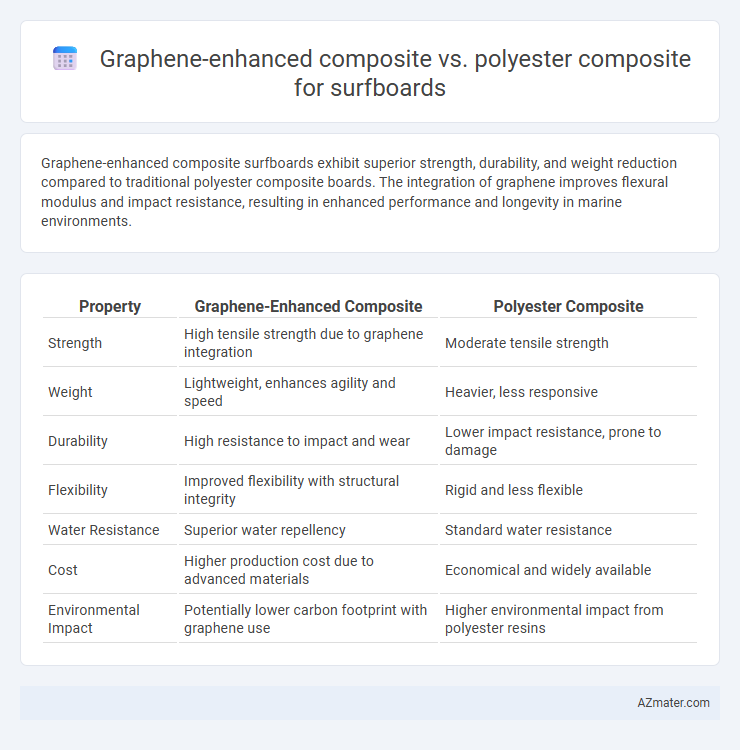Graphene-enhanced composite surfboards exhibit superior strength, durability, and weight reduction compared to traditional polyester composite boards. The integration of graphene improves flexural modulus and impact resistance, resulting in enhanced performance and longevity in marine environments.
Table of Comparison
| Property | Graphene-Enhanced Composite | Polyester Composite |
|---|---|---|
| Strength | High tensile strength due to graphene integration | Moderate tensile strength |
| Weight | Lightweight, enhances agility and speed | Heavier, less responsive |
| Durability | High resistance to impact and wear | Lower impact resistance, prone to damage |
| Flexibility | Improved flexibility with structural integrity | Rigid and less flexible |
| Water Resistance | Superior water repellency | Standard water resistance |
| Cost | Higher production cost due to advanced materials | Economical and widely available |
| Environmental Impact | Potentially lower carbon footprint with graphene use | Higher environmental impact from polyester resins |
Introduction to Composite Materials in Surfboards
Graphene-enhanced composites significantly improve surfboard performance by increasing strength-to-weight ratio and enhancing flexibility compared to traditional polyester composites. These advanced materials provide superior durability and impact resistance, reducing the risk of damage while maintaining lightweight properties essential for agility in the water. Incorporating graphene into surfboard construction leverages nanomaterial innovation to optimize ride quality and board longevity.
What is Graphene-Enhanced Composite?
Graphene-enhanced composite integrates graphene, a single layer of carbon atoms with exceptional strength and conductivity, into traditional surfboard materials to improve durability and performance. This advanced composite offers superior stiffness, impact resistance, and reduced weight compared to standard polyester composites, enhancing wave responsiveness and board longevity. The inclusion of graphene creates a stronger molecular bond within the polyester matrix, resulting in a more resilient surfboard construction.
Overview of Polyester Composite in Surfboards
Polyester composite in surfboards is a traditional material composed of polyester resin combined with fiberglass cloth, offering durability and affordability for mass production. It provides a balanced rigidity and weight but tends to be less flexible and more prone to yellowing and degradation over time compared to advanced composites. Widely used since the mid-20th century, polyester composites remain the industry standard for surfboards due to their ease of shaping, strong bonding properties, and cost-effectiveness.
Mechanical Strength: Graphene vs Polyester
Graphene-enhanced composites exhibit significantly higher mechanical strength compared to traditional polyester composites, offering superior tensile strength and impact resistance crucial for surfboard durability. The incorporation of graphene nanoparticles into the composite matrix improves stiffness and fatigue resistance, reducing the risk of fractures and extending the surfboard's lifespan. Polyester composites, while cost-effective, typically lack the enhanced tensile properties and damage tolerance provided by graphene, making them less optimal for high-performance surfboards subjected to intense mechanical stress.
Flex and Performance Characteristics
Graphene-enhanced composites significantly improve surfboard flex and responsiveness compared to traditional polyester composites by increasing stiffness-to-weight ratio and energy return. The incorporation of graphene results in enhanced tensile strength and impact resistance, allowing for better flex control and durability under dynamic wave conditions. Polyester composites, while cost-effective, tend to flex less efficiently and may suffer from reduced performance in high-stress maneuvers due to lower material strength and fatigue resistance.
Durability and Impact Resistance
Graphene-enhanced composites exhibit significantly higher durability and impact resistance compared to traditional polyester composites used in surfboards. The incorporation of graphene improves tensile strength and reduces material fatigue, enhancing the board's ability to withstand repeated wave impacts and harsh marine conditions. Polyester composites, while cost-effective, tend to be more prone to cracking and delamination under stress, making graphene-enhanced surfboards a superior choice for longevity and performance.
Weight and Buoyancy Comparison
Graphene-enhanced composites significantly reduce surfboard weight compared to traditional polyester composites, offering superior strength-to-weight ratios that improve maneuverability. This weight reduction enhances buoyancy by allowing boards to sit higher on the water, facilitating easier paddling and better wave catching. Polyester composites, while durable, tend to be heavier and less buoyant, which can hinder overall performance in the water.
Cost and Manufacturing Implications
Graphene-enhanced composites for surfboards offer superior strength-to-weight ratios and durability compared to traditional polyester composites, but they come with higher material costs and require specialized manufacturing techniques. The integration of graphene can improve impact resistance and extend surfboard lifespan, potentially offsetting initial expenses over time. Manufacturing processes for graphene composites demand precise control of dispersion and curing, leading to increased production complexity and cost compared to the more established, cost-effective polyester composite methods.
Environmental Considerations
Graphene-enhanced composites offer improved durability and longevity compared to traditional polyester composites, reducing the frequency of surfboard replacement and associated environmental waste. These advanced materials can potentially lower the carbon footprint due to their lightweight nature, which decreases transportation emissions and energy consumption during production. Polyester composites, while widely used, rely on petrochemical resins that are less sustainable and contribute more significantly to environmental pollution through volatile organic compound (VOC) emissions and non-biodegradable waste.
Future Trends in Surfboard Material Innovation
Graphene-enhanced composites are revolutionizing surfboard design by offering superior strength-to-weight ratios and enhanced flexibility compared to traditional polyester composites, enabling more durable and responsive boards. Future trends indicate that the integration of graphene will lead to highly customized surfboards with improved impact resistance and environmental sustainability due to reduced resin usage. Advancements in nanotechnology and composite manufacturing processes are expected to further optimize performance characteristics, making graphene-based materials the forefront of surfboard innovation.

Infographic: Graphene-enhanced composite vs Polyester composite for Surfboard
 azmater.com
azmater.com